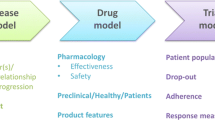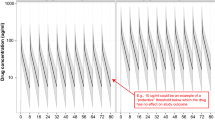Clinical trial simulations make use of input/output models with covariate effects; the virtual patient population generated for the simulation should therefore display physiologically reasonable covariate distributions. Covariate distribution modeling is one method used to create sets of covariate values (vectors) that characterize individual virtual patients, which should be representative of real subjects participating in clinical trials. Covariates can be continuous (e.g., body weight, age) or categorical (e.g., sex, race). A modeling method commonly used for incorporating both continuous and categorical covariates, the Discrete method, requires the patient population to be divided into subgroups for each unique combination of categorical covariates, with separate multivariate functions for the continuous covariates in each subset. However, when there are multiple categorical covariates this approach can result in subgroups with very few representative patients, and thus, insufficient data to build a model that characterizes these patient groups. To resolve this limitation, an application of a statistical methodology (Continuous method) was conceived to enable sampling of complete covariate vectors, including both continuous and categorical covariates, from a single multivariate function. The Discrete and Continuous methods were compared using both simulated and real data with respect to their ability to generate virtual patient distributions that match a target population. The simulated data sets consisted of one categorical and two correlated continuous covariates. The proportion of patients in each subgroup, correlation between the continuous covariates, and ratio of the means of the continuous covariates in the subgroups were varied. During evaluation, both methods accurately generated the summary statistics and proper proportions of the target population. In general, the Continuous method performed as well as the Discrete method, except when the subgroups, defined by categorical value, had markedly different continuous covariate means, for which, in the authors’ experience, there are few clinically relevant examples. The Continuous method allows analysis of the full population instead of multiple subgroups, reducing the number of analyses that must be performed, and thereby increasing efficiency. More importantly, analyzing a larger pool of data increases the precision of the covariance estimates of the covariates, thus improving the accuracy of the description of the covariate distribution in the simulated population.
Similar content being viewed by others
References
N. H. G. Holford, M. Hale, H. C. Ko, J.-L. Steimer, and C. C. Peck (eds.). P. Bonate, W. R. Gillespie, T. Ludden, D. B. Rubin, L. B. Sheiner, and D. Stanski (contributors). Simulation in Drug Development: Good Practices. http://cdds.georgetown. edu/research/sddgp723.html
Bonate P.L. (2000). Clinical trial simulation in drug development. Pharm. Res. 17:252–256
Holford N.H.G., Monteleone J., Kimko H., Peck C. (2000). Simulation of clinical trials. Annu. Rev. Pharmacol. Toxicol. 40:209–234
Chabaud S., Girard P., Nony P., Boissel J.P. (2002). Clinical trial simulation using therapeutic effect modeling: Application to ivabradine efficacy in patients with angina pectoris. J. Pharmacokinet. Pharmacodyn. 29(4):339–363
Lemmens H.J.M., Wada D.R., Munera C., Eltahtawy A., Stanski D.R. (2006). Enriched analgesic efficacy studies: An assessment by clinical trial simulation. Contemp. Clin. Trials 27(2):165–173
Veyrat-Follet C., Bruno R., Olivares R. (2000). Clinical trial simulation of docetaxel in patients with cancer as a tool for dosage optimization. Clin. Pharmacol. Ther. 68:677–678
Kastrissios H., Rohatagi S., Moberly J., Truitt K., Gao Y., Wada D.R., Takahashi M., Kawabata K., Salazar D. (2006). Development of a predictive pharmacokinetic model for a novel cyclooxygenase-2 inhibitor. J. Clin. Pharmacol. 46(5):537–548
Kowalski K.G., Hutmacher M.M. (2001). Design evaluation for a population pharmacokinetic study using clinical trial simulation: A case study. Stat. Med. 20:75–91
Mould D.R. (2003). Defining covariate distribution models for clinical trial simulation. In: Kimko H.C., Duffull S.B. (eds). Simulation for Designing Clinical Trials: A Pharmacokinetic–Pharmacodynamic Modeling Perspective. Marcel Dekker, New York, pp. 31–53
Evans M., Hastings N., Peacock B. (1993) Statistical Distributions. John Wiley & Sons, Inc., New York, pp. 102–105
S. L. Beal and L. B. Sheiner (eds.). NONMEM Users Guides, Icon Development Solutions, Ellicott City, MD (1989–98).
B. Schmeiser. Advanced input modeling for simulation experimentation. In P. A. Farrington, H. B. Nembhard, D. T. Sturrock, and G. W. Evans (eds.), Proceedings of the 1999 Winter Simulation Conference, 1999, pp. 110–115.
M. Kaut and S. W. Wallace. Evaluation of scenario-generation methods for stochastic programming (2003). http://citeseer.ist.psu.edu/cache/papers/cs/29430/http:zSzzSzwww.iot.ntnu.nozSz~mkautzSzCV_and_studyzSzSG_evaluation.pdf/kaut03evaluation.pdf
S. Ghosh and S. G. Henderson. Chessboard distributions and random vectors with specified marginals and covariance matrix. Working paper, Department of Industrial and Operations Engineering, University of Michigan, Ann Arbor (2000).
M. C. Cario and B. L. Nelson. Modeling and generating random vectors with arbitrary marginal distributions and correlation matrix. Technical Report, Department of Industrial Engineering and 35 Management Sciences, Northwestern University, Evanston, Illinois (1997).
Lapin L. (1983) Probability and Statistics for Modern Engineering 2nd edn. PWS-KENT Publishing Company, Boston, pp. 215–217
Williams R.H., Larson P.R. ed. (2002) Williams Textbook of Endocrinology 10th edn. W.B. Saunders Co., Illinois, pp. 622, 726
McDonough P., Moffatt R. (1999). Smoking-induced elevations in blood carboxyhaemoglobin levels. Effect on maximal oxygen uptake. Sports Med. 27:275–283
Author information
Authors and Affiliations
Corresponding author
Rights and permissions
About this article
Cite this article
Tannenbaum, S.J., Holford, N.H.G., Lee, H. et al. Simulation of Correlated Continuous and Categorical Variables using a Single Multivariate Distribution. J Pharmacokinet Pharmacodyn 33, 773–794 (2006). https://doi.org/10.1007/s10928-006-9033-1
Received:
Accepted:
Published:
Issue Date:
DOI: https://doi.org/10.1007/s10928-006-9033-1




